Key points
A common factorA whole number which is a factor of two or more numbers. Eg, 2, 5 and 10 are common factors of 30 and 20 is a whole number which is a factorA whole number that will divide into a selected number with no remainder. of two or more numbers.
The highest common factor (HCF) The largest factor that will divide into the selected numbers. Eg, 10 is the highest common factor of 30 and 20. Highest common factor is written as HCF. (HCF) is the greatest factor that will divide into two or more numbers.
The lowest common multiple (LCM)The lowest multiple that is common to two or more numbers. The LCM of 15 and 12 is 60 because it is the lowest value in both of their multiplication tables. Also known as the least common multiple. (LCM) is the smallest multipleAn integer that is in the multiplication table of a specific number. Eg, 20 is a multiple of ten because 20 is in the ten times table. that is common to two or more numbers.
The HCF and LCM:
- are used when adding and subtracting fractions.
- can be found by listing factors and multiples. For larger values, expressing numbers as a product of prime factorsThe factors of 12 are 1, 2, 3, 4, 6 and 12. The prime factors of 12 are 2 and 3. 12 may be expressed as a product of its prime factors: 12 = 2 Г— 2 Г— 3 is a more efficient method. A Venn diagramA simple visual diagram with overlapping circles, used to show the relationships between two different groups or sets. can also be used.
Knowing how to find factors, draw factor treeA method to find the prime factors of a number by finding factor pairs. and write numbers as a product of their prime factors is useful to know when finding common factors, the HCF and LCM.
How to find common factors
A common factorA whole number which is a factor of two or more numbers. Eg, 2, 5 and 10 are common factors of 30 and 20 is a whole number which is a factorA whole number that will divide into a selected number with no remainder. of two or more numbers. Eg, 2, 5 and 10 are common factors of 30 and 20
1 is a common factor of all whole numbers.
To find common factors:
List the factors of each number.
Compare the factors to find numbers that are the same (or common) in each list.
Examples
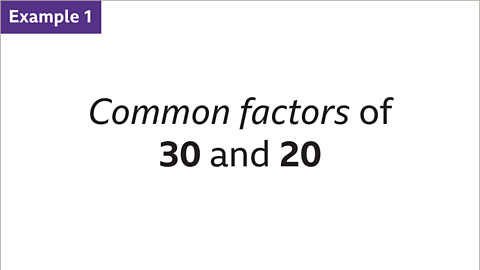
Image caption, Find the common factors of 30 and 20
Image caption, List the factors of 30 and the factors of 20
Image caption, Compare the lists of factors to find numbers that occur in both lists. These are the common factors. The common factors of 30 and 20 are 1, 2, 5, and 10
Image caption, Find the common factors of 24 and 25
Image caption, List the factors of 24 and the factors of 25
Image caption, Compare the lists of factors to find numbers that occur in both lists. The only common factor of 24 and 25 is 1
Image caption, Find the common factors of 12, 36 and 60
Image caption, List the factors of 12, the factors of 36 and the factors of 60
Image caption, Compare the lists of factors to find numbers that occur in all three lists. The common factors of 12, 36 and 60 are 1, 2, 3, 4, 6, and 12.12 is a factor of both 36 and 60, so all its factors will be common factors of 36 and 60
1 of 9
Question
What are the common factors of 40, 72 and 96?
List the factors of each of the numbers 40, 72 and 96
Identify the common factors that occur in all three lists.
The common factors of 40, 72 and 96 are 1, 2, 4 and 8
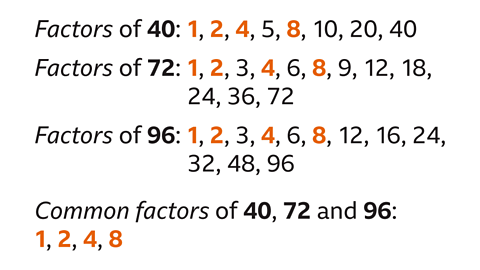
Find the HCF of two or more numbers
The highest common factor (HCF) The largest factor that will divide into the selected numbers. Eg, 10 is the highest common factor of 30 and 20. Highest common factor is written as HCF. (HCF) is the greatest factor that will divide into two or more numbers.
The HCF of two or more numbers can be found by listing the factors. For larger numbers, prime factorisationExpressing a number as a product of its prime factors. Eg, 30 written as a product of its prime factors is 30 = 2 Г— 3 Г— 5 can be used. Prime factorisation means expressing the numbers as a product of prime factorsThe factors of 12 are 1, 2, 3, 4, 6 and 12. The prime factors of 12 are 2 and 3. 12 may be expressed as a product of its prime factors: 12 = 2 Г— 2 Г— 3 .
By listing:
List the factors of each number.
Compare the lists to find the greatest number common to both.
By prime factorisation:
Draw factor treeA method to find the prime factors of a number by finding factor pairs. for each number. You may need to review how to draw a factor tree.
Write each number as a product of its prime factors. It can be easier to not use indexPositioned above and to the right of a number. It is an abbreviation of repeated multiplication. Eg, 7Ві means 7 x 7 x 7 form.
Identify the common prime factorThe factors of a number that are prime. Eg, the factors of 21 are 1, 3, 7 and 21. The prime factors of 21 are 3 and 7 in each product of prime factors.
To find the HCF, multiply the common prime factors.
Remember: index form is an abbreviation for repeated multiplication. Eg, 5ВІ means 5 Г— 5. 5Ві means 5 Г— 5 Г— 5
Examples
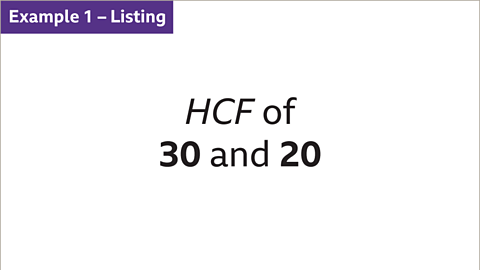
Image caption, Find the highest common factor (HCF) of 30 and 20 by listing the numbers.
Image caption, List the factors of 30 and the factors of 20
Image caption, Compare the lists of factors to find the greatest number that occurs in both lists. The HCF of 30 and 20 is 10
Image caption, Find the HCF of 30 and 20 using prime factorisation.
Image caption, Draw a factor tree for 30 and a factor tree for 20. The factor trees are both complete - the prime factors are circled. Use the factor trees to write 30 and 20 as a product of their prime factors.
Image caption, Identify the common prime factors. The common prime factors of 30 and 20 are 2 and 5
Image caption, To find the HCF of 30 and 20, multiply the common prime factors. 2 x 5 = 10. The HCF of 30 and 20 is 10
Image caption, When the prime factorisation of numbers has already been completed, the HCF of the numbers can still be found. Given that 936 is 2Ві Г— 3ВІ Г— 13 and 810 is 2 Г— 3вЃґ Г— 5, find the HCF of 936 and 810
Image caption, Write out the products of prime factors. It will be easier to spot the common prime factors if the products are not in index form. The common prime factors are 2, 3 and 3
Image caption, To find the HCF of 936 and 810, multiply the common prime factors. 2 x 3 x 3 = 18. The HCF of 936 and 810 is 18
1 of 10
Question
Find the HCF of 30 and 36
By listing
List the factors of 30 and the factors of 36. The highest factor that is common to both lists is the HCF of 30 and 36
Factors of 30: 1, 2, 3, 5, 6,10, 15, 30
Factors of 36: 1, 2, 3, 4, 6, 9, 12, 18, 36
HCF of 30 and 36 = 6
By prime factorisation
Draw and complete a factor tree for 30 and a factor tree for 36
Use the factor trees to write 30 and 36 as a product of their prime factors.
- 30 = 2 Г— 3 Г— 5
- 36 = 2 Г— 2 Г— 3 Г— 3
The common prime factors are 2 and 3. Multiply the common prime factors to find the HCF. 2 Г— 3 = 6
HCF of 30 and 36 = 6

Find the LCM of two or more numbers.
A multipleAn integer that is in the multiplication table of a specific number. Eg, 20 is a multiple of ten because 20 is in the ten times table. is an integerIntegers are numbers with no fraction or decimal part. They can be positive, negative or zero. 42, 8, and 10000 are examples of integers. that is in the multiplication table of a specific number.
The lowest common multiple (LCM)The lowest multiple that is common to two or more numbers. The LCM of 15 and 12 is 60 because it is the lowest value in both of their multiplication tables. Also known as the least common multiple. (LCM) is the lowest multiple that is common to two or more numbers.
The lowest common multiple (LCM) of two of more numbers can be found by listing the numbers. For larger numbers, prime factorisationExpressing a number as a product of its prime factors. Eg, 30 written as a product of its prime factors is 30 = 2 Г— 3 Г— 5 can be used.
By listing
List consecutive multiples for each number.
The first multiple to occur in every list is the LCM.
By prime factorisation
Draw factor treeA method to find the prime factors of a number by finding factor pairs. for each number.
Write each number as a product of prime factorsThe factors of 12 are 1, 2, 3, 4, 6 and 12. The prime factors of 12 are 2 and 3. 12 may be expressed as a product of its prime factors: 12 = 2 Г— 2 Г— 3 . It can be easier to not use indexPositioned above and to the right of a number. It is an abbreviation of repeated multiplication. Eg, 7Ві means 7 x 7 x 7 form.
Identify the common prime factors in each product of prime factorThe factors of a number that are prime. Eg, the factors of 21 are 1, 3, 7 and 21. The prime factors of 21 are 3 and 7 .
The prime factors that are not common to each product are unique for that number.
To find the LCM, multiply the common factors by the unique factors of one number and the unique factors of the other number.
Examples
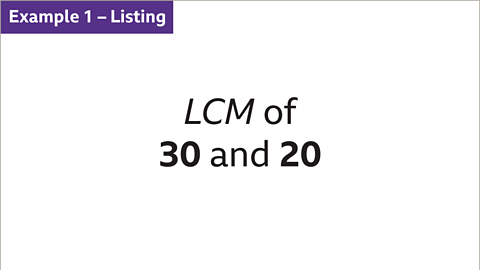
Image caption, Find the lowest common multiple (LCM) of 30 and 20 by listing each number’s multiples.
Image caption, List consecutive multiples of 30 and 20 until there is a matching multiple. This is the LCM. The LCM of 3 and 20 is 60
Image caption, Find the LCM of 30 and 20 using prime factorisation. This means expressing numbers as products of their prime factors.
Image caption, Draw a factor tree for 30 and a factor tree for 20. The factor trees are both complete - the prime factors are circled. Use the factor trees to write 30 and 20 as a product of their prime factors.
Image caption, The prime factors are circled. Use the factor trees to write 30 and 20 as a product of their prime factors. 30 = 2 Г— 3 Г— 5 and 20 = 2 Г— 2 Г— 5. The common factors are the factors that occur in the prime factorisation of both 30 and 20 - these are shown in orange. The unique factors are those that are unique to 30 (shown in blue) and unique to 20 (shown in purple).
Image caption, 30 and 20 have the prime factors 2 and 5 in common. The unique prime factor of 30 is 3. The unique prime of 20 is 2. These are needed to find the LCM.
Image caption, To find the LCM of 30 and 20, multiply the common prime factors by the unique prime factor of 30 (3) and the unique prime factor of 20 (2). 2 Г— 5 Г— 3 Г— 2 = 60. The LCM of 30 and 20 is 60
Image caption, When the prime factorisation of numbers has already been completed, the LCM of the numbers can still be found. Given that 936 is 2Ві Г— 3ВІ Г— 13 and 810 is 2 Г— 3вЃґ Г— 5, find the LCM of 936 and 810
Image caption, Write the products of prime factors without index notation. This makes it easier to spot the common prime factors. The common prime factors are 2, 3 and 3
Image caption, To find the LCM of 936 and 810, multiply the common prime factors by the unique prime factors of 936 (2, 2 and 13) and the unique prime factors of 810 (3, 3, 5). 2 Г— 3 Г— 3 Г— 2 Г— 2 Г— 13 Г— 3 Г— 3 Г— 5 = 42,120. The LCM of 936 and 810 is 42,120
1 of 10
Question
Find the LCM of 30 and 36
By listing
List multiples of 30 and 36. The first multiple that occurs in both lists is the LCM.
Multiples of 30: 30, 60, 90, 120, 150, 180, 210, 240, 270, 300…
Multiples of 36: 36, 72, 108, 144, 180…
LCM of 30 and 36 is 180
By prime factorisation
Draw and complete a factor tree for 30 and a factor tree for 36
Use the factor trees to write 30 and 36 as a product of their prime factors
30 = 2 Г— 3 Г— 5
36 = 2 Г— 2 Г— 3 Г— 3
The common prime factors are 2 and 3. The unique prime factor of 30 is 5. The unique prime factors of 36 are 2 and 3
To find the LCM, multiply the common prime factors (2 and 3) by the unique prime factor of 30 (5) and the unique prime factors of 36 (2 and 3)2 Г— 3 Г— 5 Г— 2 Г— 3 = 180
LCM of 30 and 36 is 180
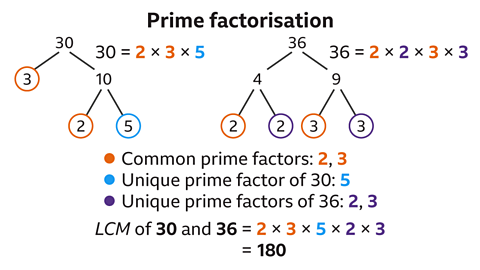
How to use a Venn diagram to find the HCF and LCM
To use a Venn diagramA simple visual diagram with overlapping circles, used to show the relationships between two different groups or sets. to find the HCF and LCM of two numbers:
Write each number as a product of prime factorsThe factors of 12 are 1, 2, 3, 4, 6 and 12. The prime factors of 12 are 2 and 3. 12 may be expressed as a product of its prime factors: 12 = 2 Г— 2 Г— 3 without using index form.
Draw a Venn diagram:
Draw a circle for each number.
Place the factors that are common to both numbers in the intersection (the overlap) of the circles.
Place the remaining prime factors for the first number in its circle.
Place the remaining prime factorThe factors of a number that are prime. Eg, the factors of 21 are 1, 3, 7 and 21. The prime factors of 21 are 3 and 7 for the second number in its circle.
Check that each circle contains the full prime factorisationExpressing a number as a product of its prime factors. Eg, 30 written as a product of its prime factors is 30 = 2 Г— 3 Г— 5 for each number.
To find the HCF of the numbers - multiply the numbers in the intersection.
To find the LCM of the numbers - multiply all the numbers in the circles in the Venn diagram.
Examples
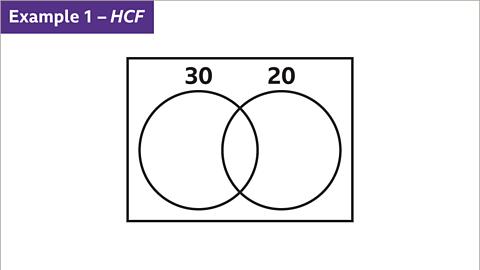
Image caption, Find the HCF and LCM of 30 and 20 using a Venn diagram.
Image caption, Write each number as a product of its prime factors. 30 = 2 x 3 x 5. 20 = 2 x 2 x 5. Then, draw the Venn diagram. Draw one circle for 30 and another for 20
Image caption, The common prime factors of 30 and 20 is 2 and 5. Place these in the intersection of the Venn diagram. To find the HCF of 30 and 20, multiply the common prime factors. 2 x 5 = 10. The HCF of 30 and 20 is 10
Image caption, Place the remaining prime factor for 30 (3) in its circle and the remaining prime factor for 20 (2) in its circle.
Image caption, Check that each circle contains all the prime factors in the product of prime factors for each number.
Image caption, Look at the whole Venn diagram. Multiply all the prime factors in the diagram. The LCM of 30 and 20 is 60
1 of 6
Question
Use the Venn diagram to find the HCF and LCM of 240 and 180
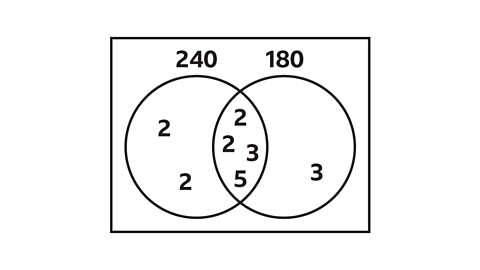
The product of prime factors in the intersection (the overlap) gives the HCF of 240 and 180
HCF of 240 and 180 = 2 Г— 2 Г— 3 Г— 5HCF = 60
The product of the prime factors in the circles gives the LCM of 240 and 180LCM of 240 and 180 = 2 Г— 2 Г— 3 Г— 5 Г— 2 Г— 2 Г— 3LCM = 720
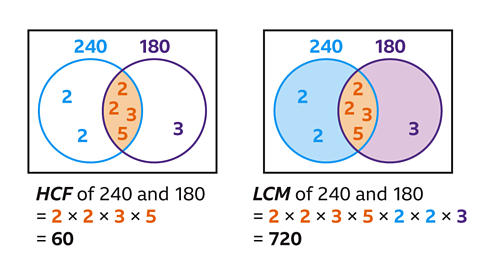
Practise common factors
Practise common factors and multiples in this quiz. You may need a pen and paper to complete some of these questions.
Quiz
Real-world maths

The HCF and LCM can be useful for a variety of businesses when ordering materials and stock.
Calculating the HCF can help an independent stationery business to use their materials efficiently – for example, when making cards. Card stock can be bought in lengths of 24 inches and 36 inches. The HCF of 24 and 36 is 12. By making cards at a size of 12 inches, they can limit the amount of waste produced from card stock.
Calculating the LCM can allow an event planner to manage their budget effectively. For example, they may want to order the same amount of stickers and tote bags to include in gift bags. If the stickers are sold in packs of 15 and gift bags are sold in packs of 6, they should buy these items in batches of 30. The LCM of 15 and 6 is 30. This means that 2 packs of stickers and 5 packs of tote bags gives 30 of each gift. This way, the event planner has matching amounts to put in the gift bags.

Game - Divided Islands
Play the Divided Islands game! gamePlay the Divided Islands game!
Using your maths skills, help to build bridges and bring light back to the islands in this free game from ґуПуґ«ГЅ Bitesize.

More on Prime numbers, factors and multiples
Find out more by working through a topic
- count4 of 4
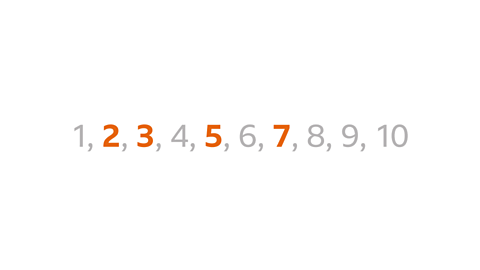
- count1 of 4
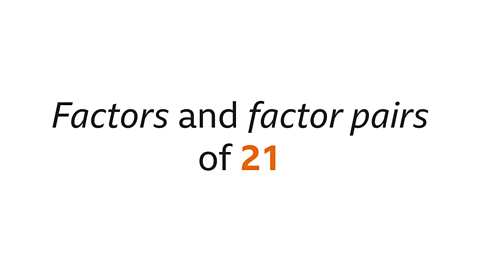
- count2 of 4
